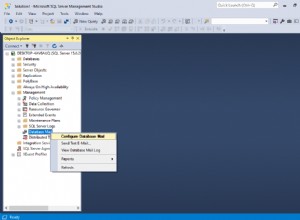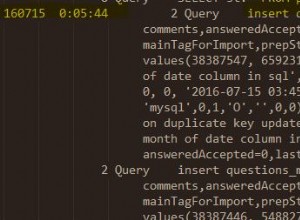Esto es un poco complicado, pero ciertamente es posible.
Comencemos por calcular el rumbo de un punto a otro. Dado un punto de partida, un rumbo y una distancia, la siguiente función devolverá el punto de destino:
CREATE FUNCTION [dbo].[func_MoveTowardsPoint](@start_point geography,
@end_point geography,
@distance int) /* Meters */
RETURNS geography
AS
BEGIN
DECLARE @ang_dist float = @distance / 6371000.0; /* Earth's radius */
DECLARE @bearing decimal(18,15);
DECLARE @lat_1 decimal(18,15) = Radians(@start_point.Lat);
DECLARE @lon_1 decimal(18,15) = Radians(@start_point.Long);
DECLARE @lat_2 decimal(18,15) = Radians(@end_point.Lat);
DECLARE @lon_diff decimal(18,15) = Radians(@end_point.Long - @start_point.Long);
DECLARE @new_lat decimal(18,15);
DECLARE @new_lon decimal(18,15);
DECLARE @result geography;
/* First calculate the bearing */
SET @bearing = ATN2(sin(@lon_diff) * cos(@lat_2),
(cos(@lat_1) * sin(@lat_2)) -
(sin(@lat_1) * cos(@lat_2) *
cos(@lon_diff)));
/* Then use the bearing and the start point to find the destination */
SET @new_lat = asin(sin(@lat_1) * cos(@ang_dist) +
cos(@lat_1) * sin(@ang_dist) * cos(@bearing));
SET @new_lon = @lon_1 + atn2( sin(@bearing) * sin(@ang_dist) * cos(@lat_1),
cos(@ang_dist) - sin(@lat_1) * sin(@lat_2));
/* Convert from Radians to Decimal */
SET @new_lat = Degrees(@new_lat);
SET @new_lon = Degrees(@new_lon);
/* Return the geography result */
SET @result =
geography::STPointFromText('POINT(' + CONVERT(varchar(64), @new_lon) + ' ' +
CONVERT(varchar(64), @new_lat) + ')',
4326);
RETURN @result;
END
Entiendo que necesita una función que tome una cadena lineal como entrada, no solo los puntos de inicio y finalización. El punto debe moverse a lo largo de una ruta de segmentos de línea concatenados y debe continuar moviéndose alrededor de las "esquinas" de la ruta. Esto puede parecer complicado al principio, pero creo que se puede abordar de la siguiente manera:
- Itera a través de cada punto de tu cadena lineal con
STPointN(), de x=1 a x=STNumPoints(). - Encuentre la distancia con
STDistance()entre el punto actual en la iteración al siguiente punto:@linestring.STPointN(x).STDistance(@linestring.STPointN(x+1)) -
Si la distancia anterior> su distancia de entrada 'n':
...entonces el punto de destino está entre este punto y el siguiente. Simplemente aplique
func_MoveTowardsPointpasando el punto x como punto inicial, el punto x+1 como punto final y la distancia n. Devuelve el resultado y rompe la iteración.Más:
...el punto de destino está más lejos en la ruta desde el siguiente punto de la iteración. Reste la distancia entre el punto x y el punto x+1 de su distancia 'n'. Continúe con la iteración con la distancia modificada.
Es posible que haya notado que podemos implementar fácilmente lo anterior de forma recursiva, en lugar de iterativa.
Hagámoslo:
CREATE FUNCTION [dbo].[func_MoveAlongPath](@path geography,
@distance int,
@index int = 1)
RETURNS geography
AS
BEGIN
DECLARE @result geography = null;
DECLARE @num_points int = @path.STNumPoints();
DECLARE @dist_to_next float;
IF @index < @num_points
BEGIN
/* There is still at least one point further from the point @index
in the linestring. Find the distance to the next point. */
SET @dist_to_next = @path.STPointN(@index).STDistance(@path.STPointN(@index + 1));
IF @distance <= @dist_to_next
BEGIN
/* @dist_to_next is within this point and the next. Return
the destination point with func_MoveTowardsPoint(). */
SET @result = [dbo].[func_MoveTowardsPoint](@path.STPointN(@index),
@path.STPointN(@index + 1),
@distance);
END
ELSE
BEGIN
/* The destination is further from the next point. Subtract
@dist_to_next from @distance and continue recursively. */
SET @result = [dbo].[func_MoveAlongPath](@path,
@distance - @dist_to_next,
@index + 1);
END
END
ELSE
BEGIN
/* There is no further point. Our distance exceeds the length
of the linestring. Return the last point of the linestring.
You may prefer to return NULL instead. */
SET @result = @path.STPointN(@index);
END
RETURN @result;
END
Con eso en su lugar, es hora de hacer algunas pruebas. Usemos la cadena de caracteres original que se proporcionó en la pregunta y solicitaremos los puntos de destino a 350 m, a 3500 m y a 7000 m:
DECLARE @g geography;
SET @g = geography::STGeomFromText('LINESTRING(-122.360 47.656,
-122.343 47.656,
-122.310 47.690)', 4326);
SELECT [dbo].[func_MoveAlongPath](@g, 350, DEFAULT).ToString();
SELECT [dbo].[func_MoveAlongPath](@g, 3500, DEFAULT).ToString();
SELECT [dbo].[func_MoveAlongPath](@g, 7000, DEFAULT).ToString();
Nuestra prueba devuelve los siguientes resultados:
POINT (-122.3553270591861 47.6560002502638)
POINT (-122.32676470116748 47.672728464582583)
POINT (-122.31 47.69)
Tenga en cuenta que la última distancia que solicitamos (7000 m) excedió la longitud de la línea lineal, por lo que se nos devolvió el último punto. En este caso, puede modificar fácilmente la función para que devuelva NULL, si lo prefiere.




